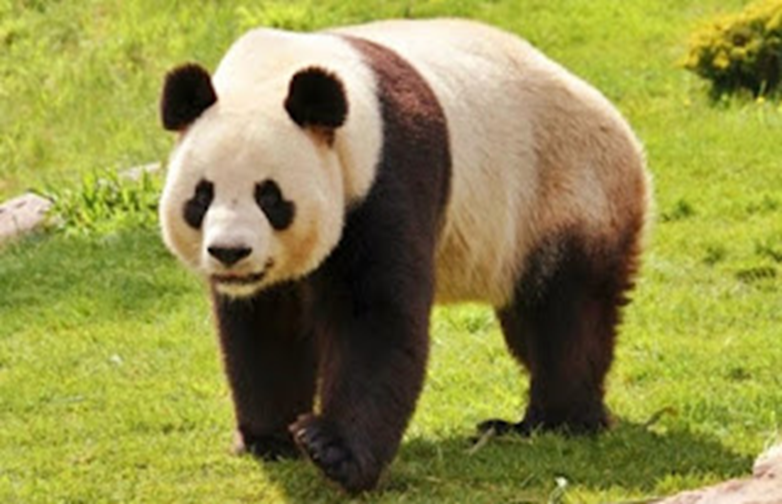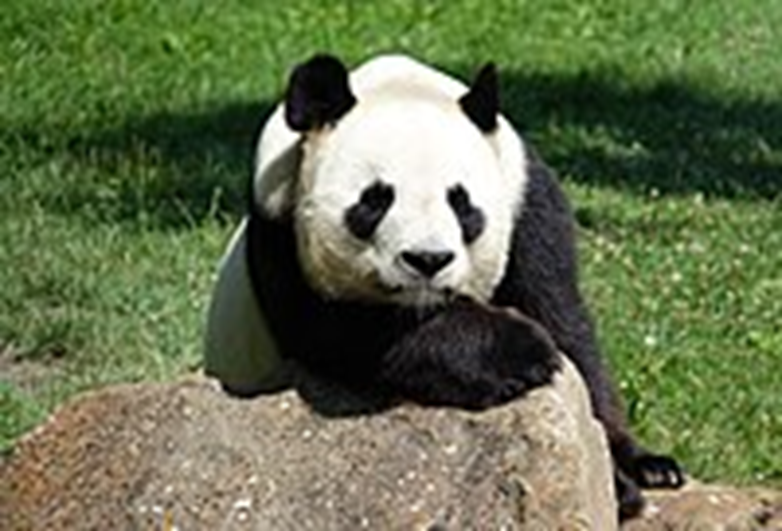An animal that is found in only one country and is considered a national treasure

These beautiful black and white bears are beloved and gentle animals loved by many people all over the world. They are also considered a symbol of China, as they do not live anywhere else, and they are known in China as the “National Treasure.” But what do we know about them? This treasure?
Below we review all the wonderful and exciting facts and information about the panda:
Habitat of the panda
The main habitat of the giant panda is Chengdu, which is Sichuan Province in China. Pandas are found in China only in Sichuan, Gansu and Shaanxi provinces. They are found in the mountains at an altitude ranging from 1,300 meters to 3,600 meters (4,200 to 12,000 feet) . Giant pandas live in forests. It is one of the rarest mammals in the world. It can only live in large bamboo forests because bamboo is their main food. Therefore, it is called the bamboo bear and is known in Chinese as Daxiongmao, meaning big cat. It is worth noting that the scientific name His name is Ailuropoda melanoleuca, which means a black and white animal with cat-like feet.

Panda
Historical facts about the panda
Pandas lived approximately 2 million years before history, as panda fossils date back to between one and two million years ago. Pandas are widely found throughout China, but now they live in the wild only in remote areas of the Tibetan foothills of China.
The external appearance of the panda
The panda bear belongs to the bear family, and the giant panda is a mammal that is distinguished by its huge body, round face, and black-and-white fur. It is considered one of the rare mammals in the world. The following are the most prominent physical characteristics of the panda bear:
The round head, plump body, and short tail are characteristics of the giant panda's external appearance. The area of its ears, the area around the eyes, the legs, and the shoulder girdle are characterized by black fur, while the rest of its body is white. Its fur is characterized by coarseness and density to keep it warm in the mountain forests where the humid and cold climate prevails. The giant panda can grasp bamboo stalks and bite them with its unique paws, as it uses one of its elongated wrist bones like its thumb to eat food, in addition to having strong jaws and teeth.
Size and weight of a panda
Pandas are much larger than we think , and they may be adorable and cute to us when we see pictures or videos of them on the Internet, but in reality they are huge and much larger than we think, as an adult panda weighs about 80-150 kg and can reach a length of about two and a half meters (5 feet).

Pandas and their love of swimming and climbing trees
Giant pandas cannot stand and do kung fu movements as some movies depict them, but in reality they can climb trees well. Pandas can start climbing trees at the age of 7 months , and since pandas are a type of bear, they can swim like other bears.
Panda color
Panda colors vary from pink to white to black or brown. Pandas are born without fur and their color is pink, then after about three weeks their color begins to gradually change until it becomes white and black. Not all giant pandas are black and white, as there are a few Very rare, brown and white.
Panda sleeping
The panda is a lazy animal that spends its day between eating and sleeping, and this is what it does throughout the day. It spends about 14 hours eating throughout the day and the rest of the time it spends sleeping.
Pandas sleep in the wild for 2 to 4 hours between meals, and the time when pandas are most active is early morning.
Panda food
Pandas love to eat bamboo shoots, as it is their favorite food, and adults can eat between 12-38 kg of bamboo per day.
Bamboo is generally not nutritious enough to keep them healthy so they have to eat a lot and quickly, already eating up to 15 percent of their body weight in 12 hours.
Pandas must eat at least two types of bamboo to survive, otherwise they will starve. The scarcity of bamboo is a threat to pandas of extinction.
A strange behavior of pandas was also observed, which is licking copper and iron. It is said that pandas have a penchant for copper and iron, and that they enjoy licking them and enjoy their food when it is presented to them in metal dishes.

Panda bear food
Panda droppings
Pandas excrete a very large amount of droppings per day, reaching 28 kg per day.
The panda and its teeth
The panda has carnivorous teeth. However, it is a vegetarian that eats bamboo and fruits. Since giant predators such as tigers with deadly teeth are no longer around the panda, the panda no longer needs to be fast or a carnivore and has turned into a bamboo-loving vegetarian. Some fruits and meat as well, but bamboo is the basis for them.
Although pandas still have the sharp teeth and digestive system of carnivores, they don't have the energy to chase anything, so their prey either literally lands in their lap or the prey is injured and extremely slow to escape.
Pandas' molars are very wide and flat, and this shape helps them chew bamboo shoots, leaves, stems, and herbs that they eat. They can also chew bamboo sticks that are an inch and a half thick, and to put the bamboo in their mouth, they hold the stems with their front claws and six fingers.
Panda fingers
The panda has six fingers to grip the bamboo and the sixth toe serves as an additional thumb that enables it to move the bamboo into shapes in order to eat its food efficiently.
Panda legs
Their four legs are covered in black fur and they have a black stripe around their shoulders as well as around their eyes and ears, and the color of their tails is white.

Panda Connect
Giant pandas are characterized by being somewhat noisy animals, especially females during the estrus cycle in zoos, but in the forest they make 11 different sounds. Giant pandas place marks on trees, rocks and grasses that indicate their identity, sex, and sometimes their social status, through a scent issued by a large gland located under their tail. Which ranges in length from 10 to 15 cm, and by rubbing it against objects such as trees and rocks to regulate communication between them through the sense of smell. Males determine their living places using it, while females use it during the estrus cycle, as indicated by the chemical analysis of these marks.
the sound
The giant panda makes a sound similar to the sound of a sheep or a baby goat, called bleating. It also produces other sounds such as screaming when angry and others similar to barking and growling. As for its young, it makes the sound of chirping and groaning. Researchers have been able to decipher 13 different sounds of the giant panda. Scientists have collected a lot of data. They analyzed vocal fingerprints and recorded their sounds in different situations, such as eating, mating, etc. Just as giant panda cubs express themselves by making several sounds in different situations.
Mating
The mating season for giant pandas occurs in the spring, during the estrus cycle of females. Males also find females through their developed sense of smell, which they also use to avoid other males. In addition to smelling, females are also located by sound. During this season, males compete in... Between them to have the opportunity to mate, as the males become very aggressive, and it may reach the point that one to five male pandas gather around each female.
Panda senses
A strong sense of sight: The panda can distinguish colors and has good vision at night. It can also determine the location of a moving object from a great distance. It has good eyesight, despite the myth that claims that it does not see well due to the small size of its eyes.
A strong sense of smell: Giant pandas can use their sense of smell, which is considered one of their most important senses, to find a mate, avoid humans, and locate their young, in addition to collecting food.
Possessing strong sounds: Pandas make sounds when they feel angry or afraid.
Intelligence: Pandas are considered intelligent animals that learn quickly. Some of them have been trained to do more than 20 tricks in one of the zoos in China, including riding a bicycle.

The life cycle of a panda
Scientists estimate that the average lifespan of giant pandas that live in the wild ranges between 15 to 20 years, while those that live in zoos can live up to 30 years. The following is an overview of the panda’s life cycle:
1- Mating
The fertilized egg is implanted in the wall of the female bear’s uterus two to three months after mating, so that the period of growth and development of the fetus continues for only two months, as indicated by the hormone levels in the female’s urine. Then she gives birth in a bamboo nest about five months after mating, and she may give birth to twins, as sometimes happens in some reserves. But this is a rare occurrence in the wild.
2- The birth of young children
The baby panda is known as (the panda). It is born pink and weighs about 141 grams and is approximately 15 cm long. It is not able to crawl until it reaches three months of age. It is noteworthy that baby pandas are considered the smallest offspring of placental mammals in relation to the size of the mother when comparing their size to the size of the mother. Its weight to its mother's weight is only about 1:800, and it is worth noting that the mother cannot usually care for all newborns if she gives birth to twins.
3- Caring for children
Young pandas spend the first hundred days of their lives in the nest, and in the first two to three weeks of their life, the mother uses her front arms and the thumb-like bones of her wrist to hug her infant. The infant’s growth is slow during the first months, so she relies on her mother for warmth and food, and after about 45 days have passed. From birth, the little ones usually open their eyes and then begin to eat bamboo easily after the baby teeth appear, that is, when they reach about 14 months of age. Pandas are usually weaned at the age of 18 to 24 months.
Giant pandas can begin to reproduce at the age of 6 to 7 years, and the mother must be separated from her young so that she can enter a new reproductive cycle. In general, the giant panda’s lifespan can be divided as follows:
Newborns: extending from the first day of birth up to 365 days, then juveniles: ranging from 12 to 18 months of age, near puberty: which are pandas whose age ranges from 19 months to four and a half years, puberty: which are more than four and a half years of age. .
Baby pandas
Beautiful panda cubs are usually born in August because the panda mating months are from March to May and the gestation period ranges from 3 to 5 months. Females mainly give birth to two panda babies and only the strongest of them survive in the wild.
Pandas live independently and alone
Panda families do not live together, but rather they live individually. Each female has a specific range in which she lives. Males also live separately from each other, except in the short mating season (from March to May), when they compete for the attention of the females.
Hibernation
Pandas differ from most other bears that hibernate in the winter. They do not hibernate in the winter, but rather head down the mountains where the weather is warm . The reason for this is that their plant food (bamboo) they eat most of the time, and it does not make them fat enough, such as The rest of the bears need to survive and eat constantly.
Panda speed
Pandas can run at a speed of 32 km/h (20 mph), which is very fast when compared to the fastest human runners, who achieve about 37 km/h.
Pandas are shy and unadventurous
Pandas are shy and do not venture into places where humans live, which makes the places where they are found very limited.
?What does a panda do all day
The panda spends her time climbing trees, especially her little playful babies, and eating bamboo roots, bamboo shoots, and bamboo leaves, as bamboo is their main daily food. She spends 12 hours of her day in this, and after she is satisfied, she sleeps for 2 to 4 hours, and when she wakes up again Looking for more food.
Pandas attract tourists
Many travelers take their trips to China in order to see pandas , and there are many places where pandas are found in China, but the best places are Chengdu (Sichuan Province), the birthplace of the panda. Chengdu in Sichuan Province has many large panda bases and nature reserves that... Protect the panda.

?How were pandas exposed to danger and what has China done to protect them
Panda areas have become limited due to agriculture and logging activity, as well as frequent panda hunting. All of this has led to the panda being exposed to danger due to the disappearance of its habitat.
On September 5, 2016, the name of the giant panda was removed from the list of endangered animals and is now on the list of rare animals. China protects the areas of giant pandas by returning agricultural lands to wild forests.
Source : websites

